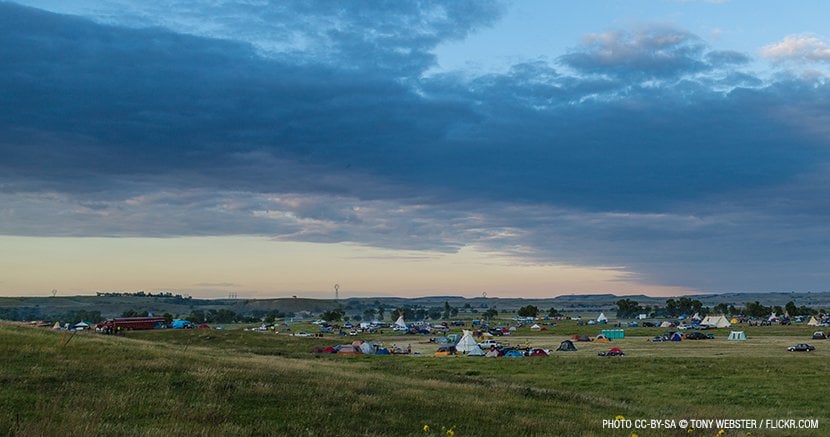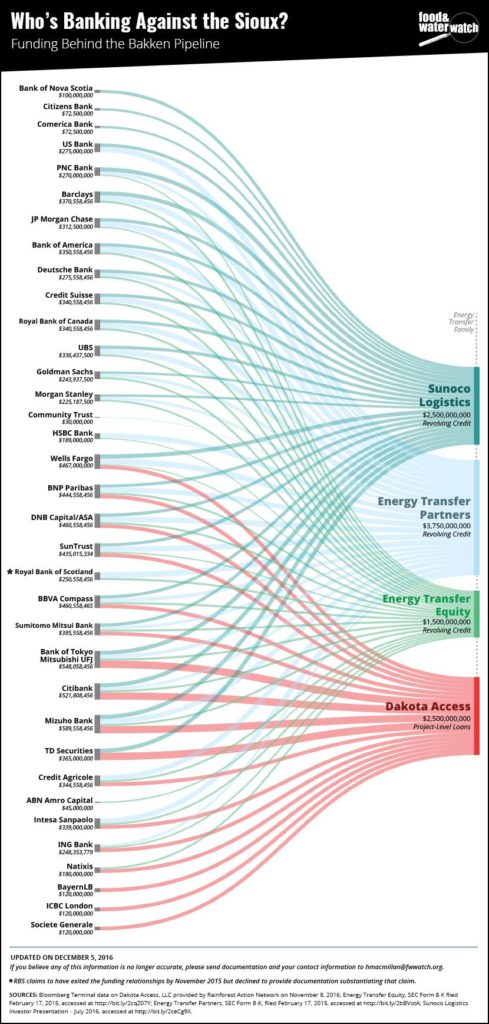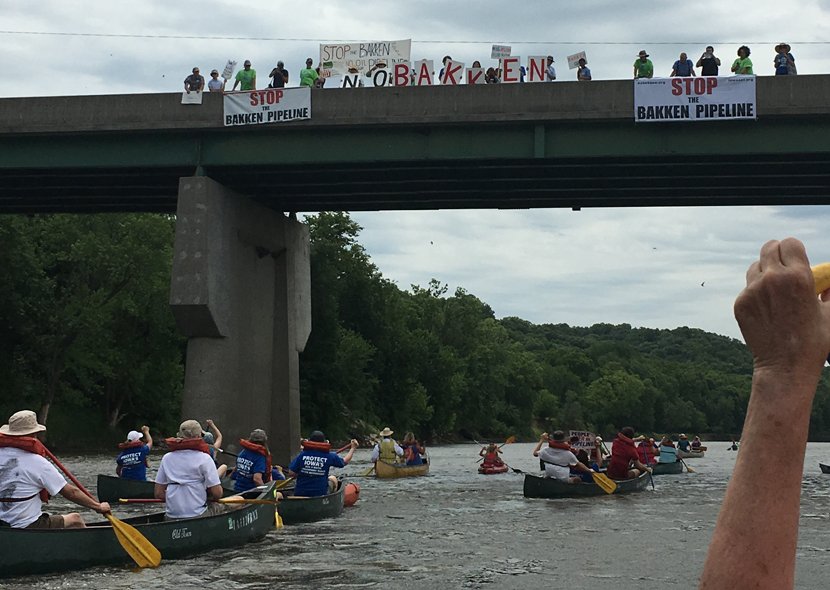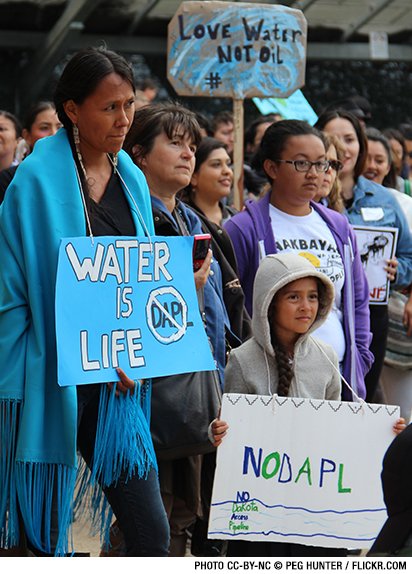Who’s Banking on the Dakota Access Pipeline?
Published Sep 5, 2016

The Standing Rock Sioux are inspiring the world with their resistance against the pipeline. But it’s not just Big Oil and Gas that they’re opposing.
When the Army Corps of Engineers issued a permit for the 1,100-mile Dakota Access Pipeline in July, executives at the corporations behind the plan probably thought their path forward was clear. They’d moved easily through the permit process, seemingly dodging the concerns of people affected by the pipeline.
But the communities in the pipeline’s path, especially local tribes, have other ideas. Thousands of people, mostly Native Americans, have converged at the Standing Rock Sioux Reservation in North Dakota to stop the pipeline from being built.
The Standing Rock Sioux call the pipeline a black snake. They know that if it were to rupture and spill, it could poison their drinking water and pollute their sacred land. Those are serious risks, given the well-documented history of pipeline leaks in the U.S.
The Standing Rock Sioux are not just up against the oil and gas industry and the federal government. They are also up against many of the most powerful financial and corporate interests on Wall Street. These profit-driven institutions are bankrolling this pipeline plan and so many others like it throughout the country.
This weekend, the pipeline company disrupted the peaceful demonstration. Its security firm unleashed violence on the activists, attacking them with dogs and pepper spray.
Nevertheless, the tribes are standing strong in their unity, and won’t give up despite these frightening and horrifying developments.
Your voice can help stop injustice like this. Join our volunteer call & text team to reach out on important issues like this.
Corporate Interests Bankrolling the Pipeline
Powerful oil and gas companies are taking appalling steps to override the Sioux’s objections. They’re using their immense financial resources to push for this pipeline to further line their pockets.
But behind the pipeline companies is a set of even more powerful Wall Street corporations. And these corporations might give you flashbacks to the 2007 financial crisis.
Here are the financial institutions banking on the Dakota Access pipeline:

Seventeen financial institutions have loaned Dakota Access LLC $2.5 billion to construct the pipeline. Banks have also committed substantial resources to the Energy Transfer family of companies to build more oil and gas infrastructure:
- Energy Transfer Partners has a revolving credit line of $3.75 billion toward expanding its oil and gas infrastructure, with commitments from 26 banks.
- Sunoco Logistics has a credit line with $2.5 billion in commitments from 24 banks.
- Energy Transfer Equity has a credit line with another $1.5 billion in commitments from most of the same big international banks.
All told, that’s $10.25 billion in loans and credit facilities from 35 banks directly supporting the companies building the pipeline. Many of the same banks have also given big credit lines to the other stakeholders in the pipeline. Those stakeholders include Phillips 66, Marathon, and Enbridge.
These banks expect to be paid back over the coming decades. By locking in widespread drilling and fracking in the false name of U.S. energy independence and security, they’re increasing our disastrous dependence on fossil fuels.
How Standing Rock Sioux are Fighting Back
The focal point of the resistance is at a camp outside the Standing Rock Sioux Reservation in North Dakota. Thousands of people, most of them Native Americans, have gathered in nonviolent demonstration to stop the pipeline’s construction and protect their land and water.
In August, youth from the tribe finished a 2,000-mile relay run to Washington, D.C. There, they brought their message to the White House in their own show of opposition. The tribe is doing everything in its power to stop this pipeline.
Even before Dakota Access’s security turned violent, the activists faced harsh responses. Governor Dalrymple has declared a state of emergency, removing water and sanitation resources from the reservation. Police have set up roadblocks around the reservation. Dozens of protesters have already been arrested, and police have spread false rumors of violence from the peaceful protectors.
But it’s the company, not the activists, that’s guilty of violence. This weekend, security sprayed activists with mace and released guard dogs into the crowd — even a pregnant woman was bitten by a dog. Democracy Now! captured disturbing footage of the attack.
In the aftermath of such violence, we can’t lose sight of how remarkable this gathering is. Over 300 North American tribes have united in solidarity with the Oceti Sakowin, or Sioux Nation effort to stop the pipeline.
Philip J. Deloria, a professor of American Culture and History at the University of Michigan, sees the fight as historic:
“The whole thing is kind of amazing, really. It’s a conjuncture of local organizing, social media activism, tribal-generated intertribal solidarity, semi-traditional ‘March on Washington’ strategies, and alliances with environmental and other political action groups… I think a lot of Indian people are seeing it as a moment of new possibility.”
Energy Transfer Partners is pushing ahead with their construction — and in North Dakota’s dirty energy-oriented economy, these corporations have the backing of the political establishment. In contrast, the activists stand against them with only their bodies. They’re protecting their sacred and sovereign land and water by physically standing in the way of the construction.
We all owe these activists our support. Communities all along the pipeline route have been carrying out their own protests. Food & Water Watch has been working with the Bakken Pipeline Resistance Coalition to block the proposal since it was first announced in 2014. Now, as the pipeline is being built, we’re asking everyone to call on your senators to intervene.

The Problems with Pipelines
Oil pipelines are inherently dangerous, and threaten our communities and environment with spills and explosions. They boost our dependence on fossil fuels and corporate profits. Yet, they bring only risks and harms to those who live along the pipelines’ paths.
The Dakota Access pipeline would pump about a half-million barrels of oil each day along 1,100 miles through the Dakotas and Iowa to Southern Illinois. There, the oil would be sent to East Coast refineries and other markets by train, or down another 750 miles to the Gulf Coast through a second pipeline that Energy Transfer Partners is converting to carry oil.
Combined, these two pipelines are called the Bakken Crude Pipeline, acknowledged here in a presentation ETP made to its stockholders in August. Together, they follow a similar path to the Keystone XL pipeline that President Obama rejected:

Overall, the Bakken Crude Pipeline will cost about $4.8 billion, and ETP is touting it as a key element of its plans to “capitalize on U.S. energy exports.” In building this infrastructure, ETP and its financial backers are banking on increased fracking in the United States in the coming decades. Over that time, communities will be stuck with the spills, explosions, water pollution, air pollution, and climate impacts.
Help Stop the Bakken Pipeline

Pipelines are not the answer to our energy needs. We need to keep fossil fuels in the ground, and we need an urgent shift to 100% renewable energy.
The Dakota Access Bakken Pipeline is a direct threat to our air, water, and clean energy future. This is why we need our elected officials to support the Standing Rock Sioux and other activists. We also need them to revoke the federal permits and deny the Bakken pipeline. Urge your senators to deny the Bakken pipeline.
Join our call & text volunteer team to reach out to people on issues like this.
Enjoyed this article?
Sign up for updates.
TO TOP





